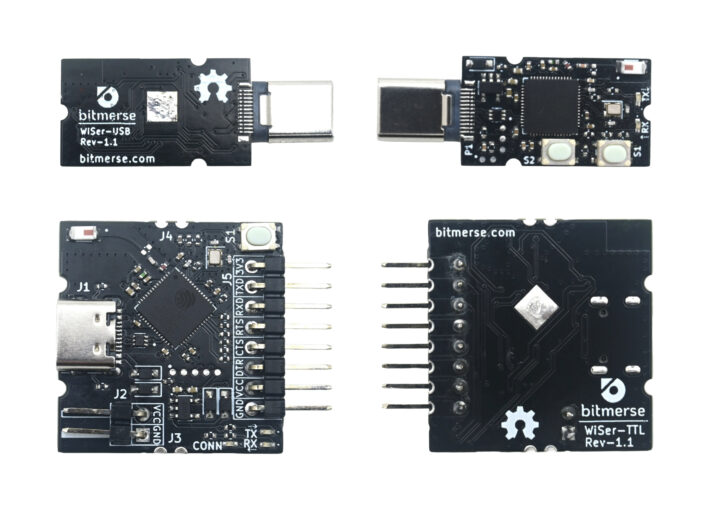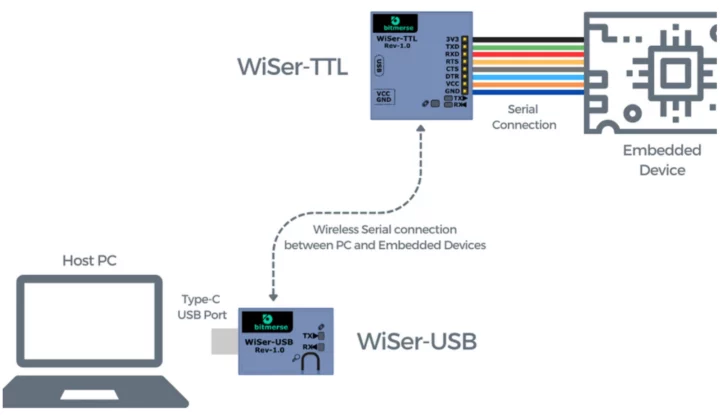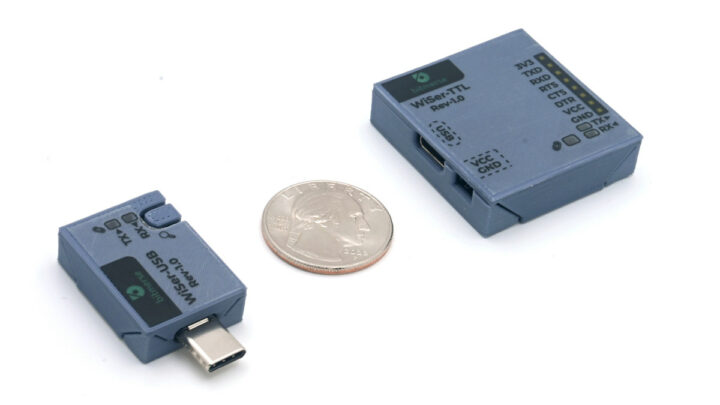WiSer is a wireless-to-serial communication kit comprised of a USB dongle (WiSer-USB) and a USB TTL debug board (WiSer-TTL) – both built around an ESP32-S2 microcontroller – that allows users to establish a P2P wireless connection between a host computer and a development board or sensor.
It works like a typical USB to TTL debug board except it operates over WiFi, and it’s especially useful to debug code, update firmware, log data, or transfer files without a USB cable or even a Wi-Fi router since the connection to peer-to-peer. It looks especially useful when the host and DUT are too far apart, and my review samples are often on another table around 1.5m from the nearest USB port of my laptop, so I could see some use for it myself…
WiSer specifications:
- Wireless SoC – ESP32-S2 Wi-Fi (and Bluetooth) microcontroller
- USB – 1x USB Type-C port providing a virtual serial port on host and for power
- Connectivity
- Peer-to-peer wireless communication over 2.4 GHz WiFi with AES-CCMP encryption (Yes, it’s relying on ESP-NOW)
- Serial
- Supported baud rates: all standard and custom rates up to 921,600 baud
- Supported data bits: 6-bit, 7-bit, 8-bit
- Supported parity types: NONE, ODD, EVEN, MARK, and SPACE
- Supported stop bits: 1 bit, 1.5 bit, 2 bit
- Supported flow control: software (XON/SF), hardware (RTS/CTS), and None
- Equipped with DTR control pin
- Misc
- RX, TX, and CONN indicator LEDs
- “FIND PAIR” button on WiSer-USB to locate the paired device (useful when deploying multiple WiSer-TTL devices)
- “BOOT” button to update ESP32-S2 firmware
- Power Supply
- WiSer-USB – 5V via USB-C port
- WiSer-TLL – 5V via header pins, or castellated pins, or USB-C port
- Dimensions
- WiSer-USB – 37.8 x 20.4 x 8.2 mm (35.8 x 14.4 x 4.7 mm without enclosure)
- WiSer-TTL – 36.5 x 38.4 x 9.8 mm (28 x 29 x 4.3 mm without enclosure and header pins)

Bitmerse says the solution is compatible with Windows, Linux, Mac, and Android without drivers, but other operating systems may be supported too since WiSer just shows as a USB serial device on the host. It’s also possible to use two Wiser-USB dongles for P2P communication between two hosts.
A quick start guide provides basic documentation to get started and a product manual builds on that for more advanced use cases. WiSer is also an open-source hardware project, and you’ll find the KiCAD hardware design files (schematics and PCB layout) and firmware source code on GitHub released under CERN-OHL-P-2.0 and MIT licenses respectively.

Bitmerse launched the Wiser kit on Crowd Supply with a $4,800 funding target. Rewards cost $60 to $65 with three options for a Host-to-Client kit, a Host-to-Host kit, or a “Board-Mountable Kit” with a Wiser-TTL board without enclosure and a WiSer-USB dongle. All three kits come with a USB Type-C cable and jumper cables. Shipping adds $8 to the US and $18 to the rest of the world, and deliveries are scheduled to start by the end of August 2024.

Jean-Luc started CNX Software in 2010 as a part-time endeavor, before quitting his job as a software engineering manager, and starting to write daily news, and reviews full time later in 2011.
Support CNX Software! Donate via cryptocurrencies, become a Patron on Patreon, or purchase goods on Amazon or Aliexpress





